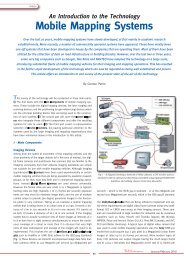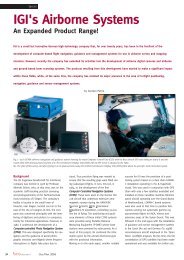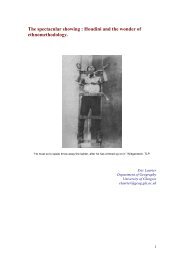MERIS atmospheric water vapor correction model for Wide Swath ...
MERIS atmospheric water vapor correction model for Wide Swath ...
MERIS atmospheric water vapor correction model for Wide Swath ...
You also want an ePaper? Increase the reach of your titles
YUMPU automatically turns print PDFs into web optimized ePapers that Google loves.
GRSL-00404-2011 <<br />
agreement between <strong>MERIS</strong> and GPS/radiosonde <strong>water</strong> <strong>vapor</strong><br />
products in terms of standard deviations [5]. <strong>MERIS</strong> near IR<br />
data have been used to reduce <strong>water</strong> <strong>vapor</strong> effects on ASAR<br />
IM interferograms, and application of the <strong>MERIS</strong> <strong>correction</strong><br />
<strong>model</strong>s to ASAR data over the Los Angeles region showed the<br />
order of <strong>water</strong> <strong>vapor</strong> effects on interferograms can be reduced<br />
Fig. 1. Coverage of ASAR Image Mode (small, black dashed rectangle),<br />
ASAR <strong>Wide</strong> <strong>Swath</strong> (black gradational rectangle) and full resolution <strong>MERIS</strong><br />
(large, white dashed rectangle) over the Bam (Iran) region. (a) Black star<br />
indicates the epicenter of the 2003 Bam (Iran) earthquake [13]; (b) Black<br />
dashed rectangle denotes the coverage of ASAR Image <strong>Swath</strong> 2 (IS2); (c)<br />
The five stripes with different colors (from dark grey to light grey to white)<br />
in the WS track imply 5 sub swaths.<br />
from ~10 mm to ~5 mm after <strong>correction</strong> [6].<br />
In this paper, we evaluate a <strong>MERIS</strong> <strong>water</strong> <strong>vapor</strong> <strong>correction</strong><br />
<strong>model</strong> <strong>for</strong> WS InSAR. It is clear that the <strong>MERIS</strong> <strong>correction</strong><br />
<strong>model</strong> <strong>for</strong> WS InSAR has several advantages over that <strong>for</strong> IM<br />
InSAR: (i) <strong>MERIS</strong> near IR <strong>water</strong> <strong>vapor</strong> products are available<br />
at two nominal spatial resolutions: 0.3 km <strong>for</strong> full resolution<br />
(FR) mode, and 1.2 km <strong>for</strong> reduced resolution (RR) mode. WS<br />
images have a more comparable spatial resolution to <strong>MERIS</strong><br />
data than IM images (150 m <strong>for</strong> WS vs. 30 m <strong>for</strong> IM); (ii) the<br />
spatial coverage of WS images is also more comparable to<br />
<strong>MERIS</strong> images than that of IM images. It should be noted that<br />
WS ASAR sub-swath 5 does not fall within the <strong>MERIS</strong><br />
coverage as shown in Fig. 1.<br />
II. <strong>MERIS</strong> WATER VAPOR CORRECTION MODEL FOR WS<br />
INSAR<br />
A <strong>MERIS</strong> <strong>water</strong> <strong>vapor</strong> <strong>correction</strong> <strong>model</strong> has been<br />
successfully incorporated into the sarmap SARscape package<br />
[12]. As shown in Fig. 2, this <strong>model</strong> involves the usual steps<br />
of image co-registration, interferogram <strong>for</strong>mation, and<br />
interferogram flattening and removal of the topographic signal<br />
by use of a DEM. At this point, the integration approach<br />
diverges from the usual interferometric processing sequence<br />
with the insertion of a zenith-path-delay difference map<br />
(ZPDDM) [6], which aims to reduce <strong>water</strong> <strong>vapor</strong> variations in<br />
interferograms be<strong>for</strong>e phase unwrapping. The ZPDDM is<br />
derived from cloud-free <strong>MERIS</strong> near IR <strong>water</strong> <strong>vapor</strong><br />
observations [4, 6], mapped from the geographic coordinate<br />
system to the radar coordinate system (range and azimuth) and<br />
subtracted from the interferogram. This corrected<br />
interferogram can be unwrapped and an adjusted baseline can<br />
be estimated by minimizing the difference between the Slant-<br />
Range-projected reference DEM and a simulated height map<br />
converted from the unwrapped phase over ground control<br />
points (GCPs). Note that the baseline refinement step is<br />
optional and only desirable if there is an overall tilt in the<br />
unwrapped phase across the interferogram. The geocoding<br />
procedure maps the corrected unwrapped phase values from<br />
the radar coordinate system into the DEM-based coordinate<br />
system, and converts the unwrapped phase values to range<br />
Fig. 2. Flowchart of <strong>Wide</strong> <strong>Swath</strong> InSAR processing with <strong>MERIS</strong> <strong>water</strong> <strong>vapor</strong><br />
<strong>correction</strong>.<br />
changes in the radar line of sight.<br />
III. APPLICATION OF THE <strong>MERIS</strong> MODEL TO THE BAM EARTHQUAKE<br />
A pair of ENVISAT ASAR WS images over the Bam (Iran)<br />
region on the descending (satellite moving south) track 306<br />
(indicated as a black rectangle in Fig. 1) was processed from<br />
the ASAR level 0 (raw data) products using the SARscape<br />
software [12]. Effects of topography were removed from the<br />
interferograms using a 3-arc-second (~90 m) posting digital<br />
elevation <strong>model</strong> (DEM) produced by the Space Shuttle Radar<br />
Topography Mission (SRTM) [13]. The WS interferogram has<br />
a perpendicular baseline of 110m, and the error in the SRTM<br />
DEM (i.e. nominally 8 m in Eurasia, [13]) might lead to a<br />
phase error of up to 0.67 radians (equivalent to a range change<br />
of 0.3 cm in the radar line of sight). There<strong>for</strong>e the topographic<br />
phase contribution can be considered negligible.<br />
Fig. 3(a) shows the original wrapped interferogram in the<br />
radar coordinate system. Asymmetric de<strong>for</strong>mation signals can<br />
be observed in the epicentre region (indicated by a black<br />
rectangle), the pattern of which is similar to the descending IM<br />
interferogram (track 120) as shown in Fig. 4(b) in Funning et<br />
al. (2005). It is also clear in Fig. 3(a) that there are five<br />
irregular fringes in the far field across the 400 km × 400 km<br />
region. After refining the baseline using 44 GCPs (indicated as<br />
2
















